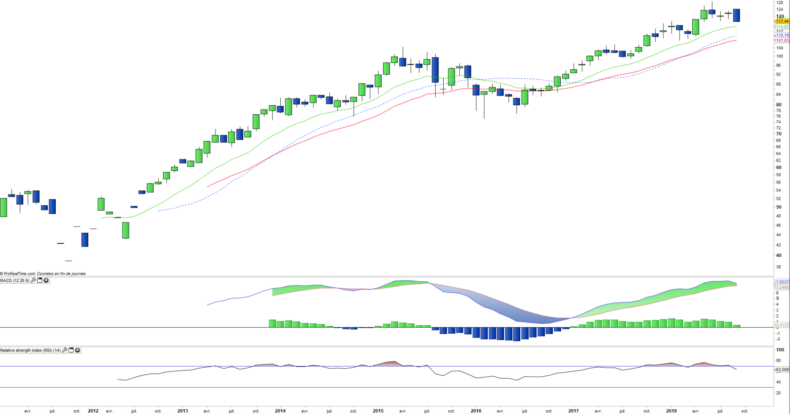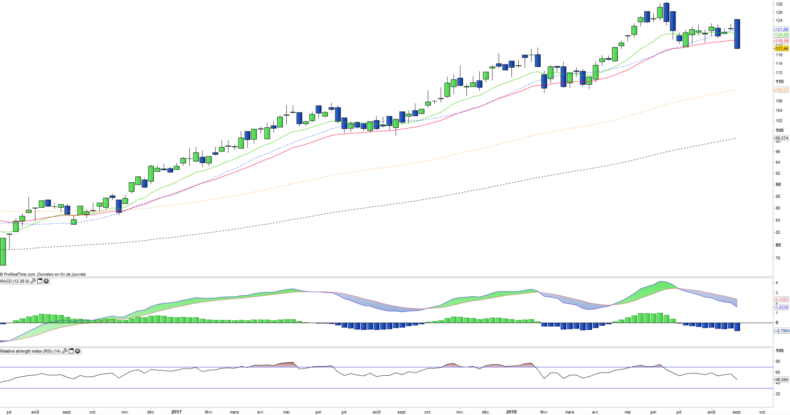Amundi Global Luxury (GLUX) - 07/09/2018
Short Term strategy: Positive (30%) / Trend -
Long Term strategy: Positive (90%) / Trend =
Characteristics of the ETF
The GLUX (Amundi) tracker replicates the S & P Global Luxury Index, which is made up of the 80 largest international luxury goods and services companies. Note that the GLUX benchmark is quoted in USD. The ETF is quoted in Euro, but bears multiple currency effects given its geographical distribution. Despite its seniority (2008), the actual history of GLUX is brief because until February 2014 this ETF replicated the MSCI Insurance index.
The costs of this ETF are low (0.25%), in particular for a thematic tracker and the AUM are approximately €53m. Replication is indirect (via a swap) and the dividend method is capitalized. The tracking error of this ETF is very low (0.09% in 3 years).
Alternative ETFs: VCR (Vanguard USD), DC6 (Amundi)
Index & components
This index is rather broad, which is reinforced by the diversity of its sub-sectors. Of the c.52% that weigh the top 10 capitalizations, the luxury automobile (Daimler, BMW, Tesla) represents c.13%, spirits (Diageo, Pernod Ricard) c.12% and luxury (LVMH, Richemont) c.13%. But GLUX also gives investors access to sectors such as luxury cruises (Carnival), clothing (Nike) and even casinos and luxury hotels (Las Vegas Sands).
All these companies share the common trait of being world leaders, with strong brands, generating high margins and regularly delivering growth levels well above the global GDP. They are more or less cyclical depending on the compartments - very cyclical for the auto part and hotels, not very cyclical for spirits - but have one thing in common, which is an important exposure to Asia and first of all China, while emerging countries become the main outlet, so India Brazil and Russia are gradually gaining importance.
The geographic distribution of GLUX makes it a good diversification tool on the theme of luxury. Europe accounts for almost 50% of the capitalization of the index, followed by the United States (39%). But Asia is also represented: Hong Kong, Japan and Korea together account for nearly 10%. Australia closes the market with 2%. GLUX has delivered a regular positive performance (8.5% in 2014, 4.7% in 2015,1.7% in 2016 and 22,1% in 2017).
This index can be volatile, as evidenced by the sharp correction between April 2015 and February 2016 (-28%) slightly higher than that of the index stoxx600 (-26%), but it is above all a growth theme related to the development of emerging economies, primarily Asian ones.
Latest developments
GLUX grew by 22.1% in 2017, more than double the performance of the Stoxx 600NR (10.6%), in particular thanks to the luxury engine and a more mixed automotive contribution.
In 2018, the index is still at +4.3% since the beginning of the year, still driven by growth in consumption and luxury goods (Pernod, Diageo, Richemont and LVMH).
Despite the current crisis in a number of emerging countries (South Africa, Argentina, Brazil, Venezuela, Turkey ...) and the risks weighing on China due to the escalating trade war with the United States coupled with restrictions on credit decisions by the government, the sector of Luxury has been a safe haven for the market until early September.
At the same time so-called "cyclical" sectors have been attacked since the beginning of the summer and the valuation gap appears difficult to maintain.
Monthly data

The monthly chart shows the construction of a top structure, which is reminiscent of the configuration of 2015. At the very least, the correction is from these beginnings and has not yet been in contact with the EMAs13 and 26 , while September's candlestick is far from being validated and just corresponds so far to a barish start on the first week of the month. However, the correction that begins seems justified by the sharp rise in the index that has been recorded for two years.
Weekly data
On the weekly chart, we can observe a bearish start in the form of a large candlestick, whose bearish influence should last for some time. A consolidation has begun and the natural target is the EMA100. The oscillators are quickly overturned and the correction could have a shape both fast and brutal, like the one that took place in August 2015.
ETF Objective
GLUX is a UCITS ETF, listed in EUR, which seeks to replicate the S&P Global Luxury (80 companies)
Characteristics
| Inception date | 09/12/2008 |
| Expense ratio | 0,25% |
| Benchmark | Indice S&P Global Luxury |
| Ticker | GLUX |
| Issuer | Amundi |
| UCITS | Yes |
| EU-SD Status | Out of scope |
| Currency | € |
| Exchange | Euronext Paris |
| Assets Under Management | 53 M€ |
| Dividend | Capitalization |
| PEA (France) | Yes |
| SRD (France) | No |
| Currency Risk | Yes |
| Number of Holdings | 80 |
| Risk | 3/5 |
Country Breakdown
| USA | 39% |
| France | 18% |
| Germany | 11% |
| United Kingdom | 11% |
| Switzerland | 6% |
| Hong Kong | 5% |
| Others | 10% |
Sector Breakdown
| Consumer discretionary | 79% |
| Consumer staples | 21% |
Top Ten Holdings
| LVMH | 9% |
| Nike | 9% |
| Diageo | 8% |
| Daimler | 6% |
| Richemont | 4% |
| Kering | 4% |
| Tesla | 3% |
| Pernod Ricard | 3% |
| BMW | 3% |
| Shiseido | 3% |

